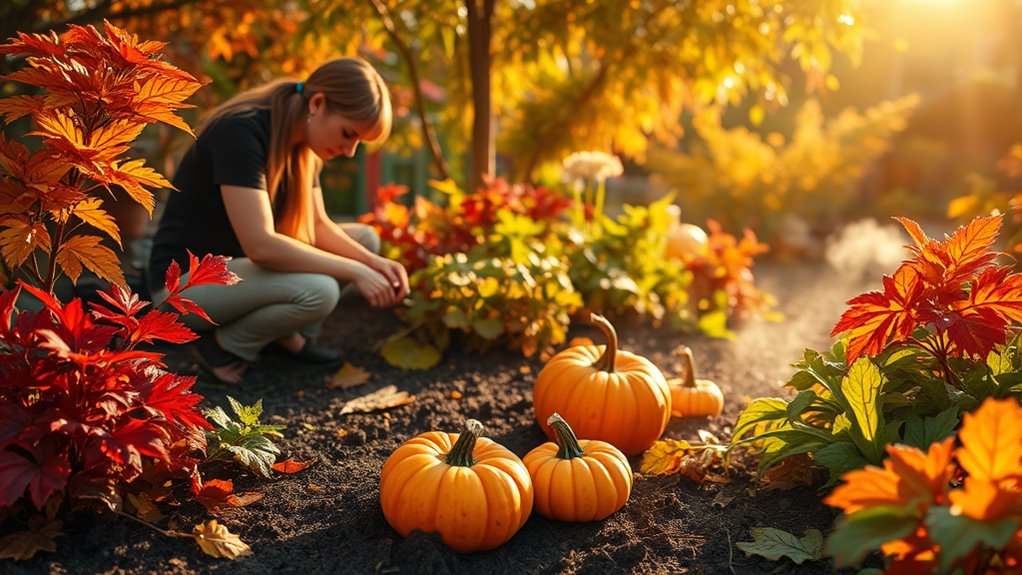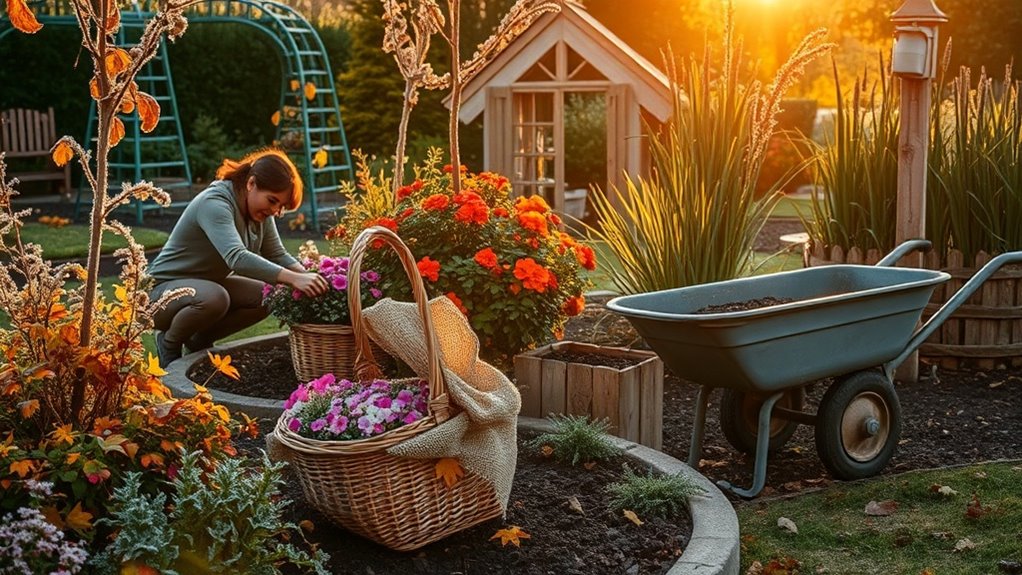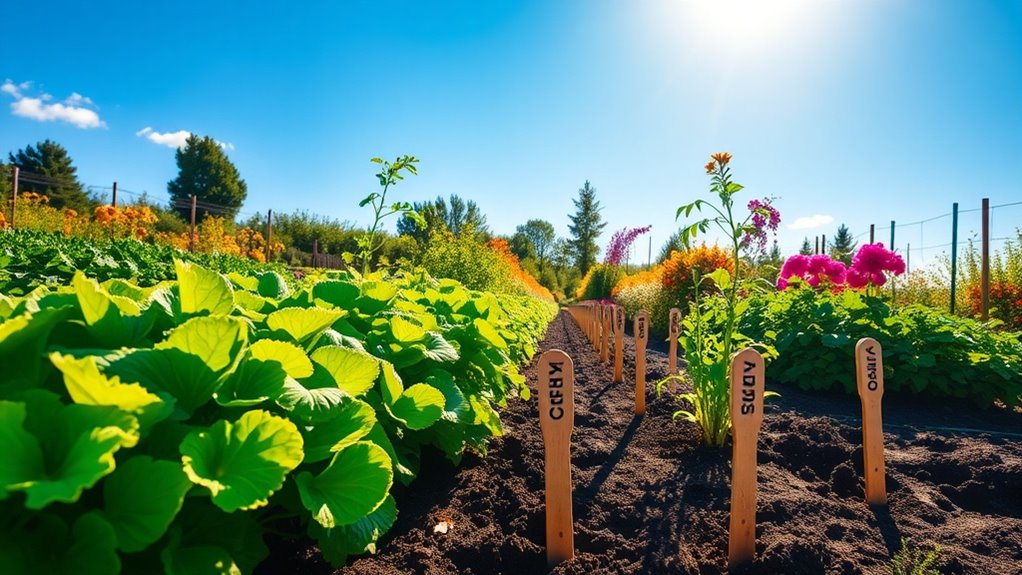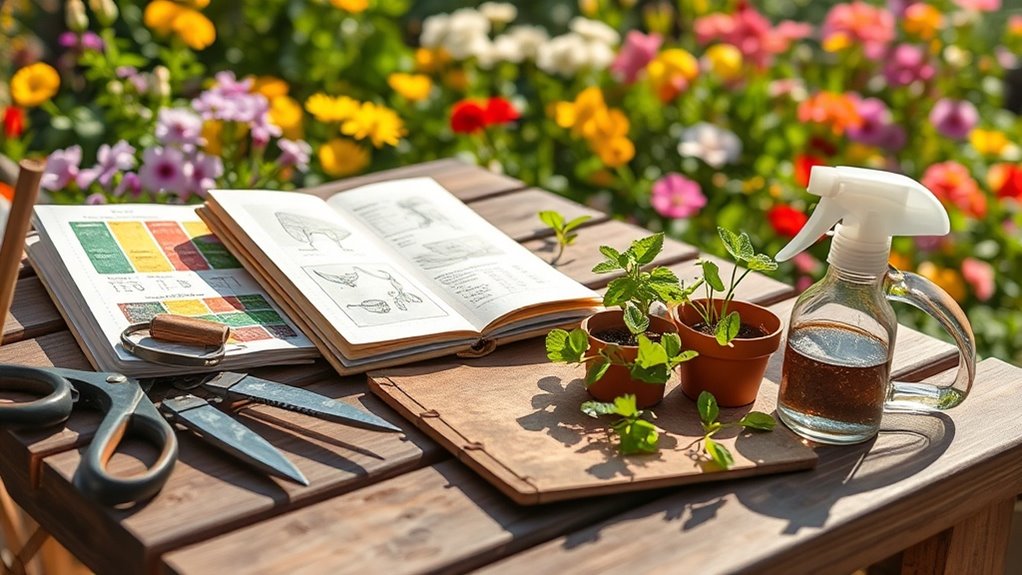Why Fall Might Be the Best Season to Garden
Fall is the best time to garden because the cooler temperatures, ranging from 50°F to 65°F, encourage robust root development. This season enhances soil quality, promotes beneficial microbial activity, and reduces pest and disease pressure. You can enjoy an extended harvest with flavorful crops like kale and Brussels sprouts. Plus, prepping your garden for winter helps create a thriving environment for next spring. There’s so much more you can discover about fall gardening benefits.
Ideal Weather Conditions for Planting
When it comes to fall gardening, understanding the ideal weather conditions for planting is essential for your success. As temperatures begin to cool, you’ll find that this season offers a unique opportunity for planting.
Aim for those crisp days, ideally between 50°F and 65°F, which promote strong root development. Pay close attention to soil moisture, ensuring it remains consistently moist but not soggy.
Timing is vital; plant your seeds or transplants at least six weeks before the first expected frost. This way, you’ll give your crops the best chance to establish before winter sets in, leading to a fruitful harvest. Additionally, fall gardening benefits from ideal soil conditions, which can enhance nutrient availability for your plants.
Enhanced Soil Quality in Fall
As fall arrives, you have a unique opportunity to enhance your soil quality through nutrient-rich composting and natural mulching.
By incorporating organic matter, you’ll not only improve soil structure but also stimulate beneficial microbial activity that thrives in cooler temperatures. Additionally, implementing fall mulching can help retain moisture and protect your plants from harsh winter conditions.
Embrace this season to enrich your garden’s foundation for a vibrant spring.
Nutrient-Rich Composting Opportunities
How can you transform your fall garden into a nutrient-rich haven?
By embracing composting, you can enrich your soil and prepare for a bountiful spring.
Fall offers unique opportunities to gather organic materials that break down beautifully.
Consider these composting options:
- Fallen Leaves: A great source of carbon, ideal for balancing green materials.
- Kitchen Scraps: Vegetable peels and coffee grounds add nitrogen and nutrients.
- Plant Debris: Use leftover plants to enhance microbial activity in the compost.
- Manure: Incorporate well-aged manure for a nutrient boost.
Start now, and your garden will thrive with vigor come spring!
Natural Mulching Benefits
Natural mulching offers incredible benefits for enhancing soil quality in your fall garden. By applying organic materials like leaves, straw, or wood chips, you create a protective layer that retains moisture and regulates soil temperature.
This insulation helps prevent erosion and keeps nutrients locked in, fostering a rich environment for your plants. As the mulch breaks down, it enriches the soil with essential organic matter, improving its structure and fertility.
Plus, this natural barrier suppresses weeds, reducing competition for resources. Incorporating mulching techniques in your fall gardening routine elevates your soil quality, setting the stage for a thriving garden come spring.
Soil Microbial Activity Boost
Soil microbial activity is essential for enhancing the quality of your fall garden.
As temperatures cool, microbial life thrives, breaking down organic matter and enriching your soil.
This process boosts nutrient availability, which is essential for plant health.
- Increased decomposition of leaves and organic matter
- Enhanced nutrient cycling, benefiting plant growth
- Improved soil structure, promoting better water retention
- Greater disease resistance through balanced microbial communities
Reduced Pest and Disease Pressure
As you shift into fall gardening, you’ll notice a significant reduction in insect activity, which means fewer pests troubling your plants.
With cooler temperatures and shorter days, the risk of plant diseases also diminishes, allowing your garden to thrive.
Embracing seasonal plant resilience not only enhances your harvest but also boosts your gardening confidence. Additionally, planting seasonal crops during this time can lead to a more robust and diverse harvest.
Decreased Insect Activity
In the cooler months of fall, you’ll notice a significant decrease in insect activity, which can greatly benefit your garden.
With fewer pests buzzing around, your plants can thrive without the constant threat of damage.
This reduction leads to:
- Less competition for resources, allowing your plants to grow stronger.
- Decreased need for chemical pesticides, promoting a healthier ecosystem.
- Increased pollination opportunities from the remaining beneficial insects.
- A more enjoyable gardening experience, free from swatting away pests.
Embrace this tranquil time to cultivate your garden; the fall season’s calm provides the perfect backdrop for growth and rejuvenation.
Fewer Plant Diseases
While the cooler fall temperatures naturally reduce pest populations, they also play an essential role in minimizing plant diseases.
As humidity decreases and sunlight shifts, conditions become less favorable for fungal pathogens and bacterial infections.
You’ll notice fewer occurrences of blights and rots, allowing your plants to thrive.
This is the perfect time to plant disease-resistant varieties, enhancing your garden’s resilience.
Additionally, the shorter days encourage your plants to focus on root development rather than foliage growth, leading to healthier, more robust specimens.
Embrace fall gardening, and you’ll cultivate a thriving landscape with reduced disease pressure.
Seasonal Plant Resilience
Seasonal plant resilience is a remarkable phenomenon that emerges in fall gardening, where the combination of cooler weather and reduced humidity creates an inhospitable environment for pests and diseases.
This natural shift benefits your plants and enhances your gardening experience.
- Many pests are less active as temperatures drop.
- Fungal diseases are less likely due to lower humidity.
- Beneficial insects, like ladybugs, thrive and help control pests.
- Fall crops can often withstand cooler temperatures, allowing for a longer growing season.
Embracing fall gardening means fewer worries about infestations and diseases, giving you the opportunity to cultivate a thriving garden.
Extended Harvest Season
One of the greatest joys of fall gardening is the opportunity for an extended harvest season, allowing you to enjoy fresh produce long after summer’s end.
As temperatures cool, many crops thrive, producing flavorful fruits and vegetables.
You can extend your harvest by using row covers or cold frames, protecting plants from frost while enhancing growth.
Varieties such as kale and Brussels sprouts become sweeter with cool weather, making them even more delicious. Additionally, fall gardening allows you to take advantage of seasonal gardening secrets, ensuring you maximize your garden’s potential during this productive time.
Fall Crops That Thrive
As autumn approaches, your garden can become a treasure trove of vibrant fall crops that thrive in cooler temperatures.
These hardy plants not only resist frost but also often taste sweeter after exposure to chilly nights.
Here are some exceptional fall crops to try:
- Kale: Packed with nutrients, kale remains tender and flavorful.
- Brussels Sprouts: These little gems develop a rich, nutty flavor in the cold.
- Radishes: Fast-growing and crisp, they add a peppery kick to salads.
- Carrots: Sweeten as the temperatures drop, making them a perfect fall delight.
In addition to these crops, consider adding easy seasonal gardening tips to enhance the visual appeal of your garden.
Embrace the season and cultivate these resilient wonders!
Preparing Your Garden for Winter
Preparing your garden for winter involves more than just cleaning up the remnants of your fall harvest; it’s about setting the stage for a vibrant spring. Start by removing debris and weeds, as they can harbor pests. Next, consider mulching to insulate your soil and protect your plants. Mulch not only helps retain moisture but also improves soil health, creating a thriving environment for your garden. Here’s a quick reference table to help you:
| Task | Purpose | Timing |
|---|---|---|
| Clean up debris | Prevent pests and diseases | Late fall |
| Apply mulch | Insulate soil | After first frost |
| Soil amendments | Improve fertility | Before freeze |
| Plant cover crops | Prevent erosion | Early fall |
| Winterize tools | Increase longevity | Pre-winter |





